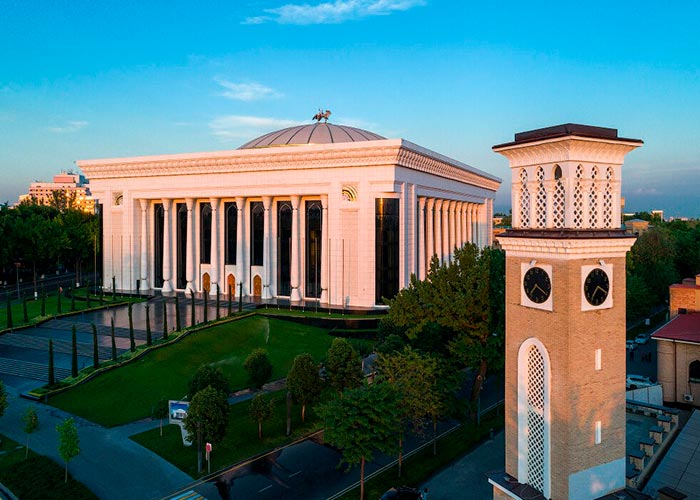


The mausoleum of Abubakr al-Shashi Kaffal
According to historical references, the famous ensemble Hast Imam in Tashkent arise based on the construction of the mausoleum of Kaffal Abubakr al-Shashi. Historical buildings became erected around this ensemble, which eventually cause the emergence of a whole complex of religious buildings.
Al-Al-Shashi Kaffal lived many years ago and even in the 10th century, people gave him the dignity "Hazrat Imam", which means - "The Holy Imam." During his teachings years, Abubakr travelled the world and very often was in Mecca. His knowledge about religion is very appreciated, respected and revered. He was not only a thinker and philosopher but also a poet. Unfortunately, we have been able to save only a part of his works.
Kaffal Abubakr al-Shashi was buried in the walls of old Tashkent in a place where the ensemble, Hast Imam situated. Therefore, the mausoleum got the same name, in honour of the preacher and scholar.
The original mausoleum, which was built in the 10th century, has not survived to the present day. In the 19th century, people erected a new building. By the way, if you are very careful, you will be able to see on the facade not only the names of the poems of those who participated in the construction of the mausoleum but the encrypted date of completion of construction of the mausoleum.
When you will read this good scripture,
Make a supportive prayer for my soul.
Builder of the irreproachable building -
The faithful servant of Ghulam Husain Khan.
The Mausoleum of Kaffal Abubakr al-Shashi was built in the style of khanaka. The “khanaka’’ is translated from Persian as Sufi abode. Khanaka was used as a shelter for dervishes. They were built in a square and had an asymmetrical layout.
The Mausoleum of Kaffal Abubakr al-Shashi is located on a hill, thus visually it rises above the other buildings, which are located in the ensemble Hast Imam. Entrance to the Mazar is directed to the north. The mausoleum Abubakr has a cross-shaped hall and three-tier octagonal hujras (cells) together with thyroid sails for pilgrims. His cell is located at the corner pylons.
Alas, but the 16th century can be attributed only to the walls of the mausoleum. Everything else that you can see inside is the result of numerous restorations. The ancient marble tombstones with inscriptions damaged, collected during the restoration from the entire ensemble Hast Imam.
Our travel agency «Orient Mice», will be happy to provide you with transport, hotel and professional guides who will show you not only the city but also tell amazing stories about the architectural monuments of Tashkent.
Kaffal Abubakr al-Shashi was buried in the walls of old Tashkent in a place where the ensemble, Hast Imam situated. Therefore, the mausoleum got the same name, in honour of the preacher and scholar.
The original mausoleum, which was built in the 10th century, has not survived to the present day. In the 19th century, people erected a new building. By the way, if you are very careful, you will be able to see on the facade not only the names of the poems of those who participated in the construction of the mausoleum but the encrypted date of completion of construction of the mausoleum.
When you will read this good scripture,
Make a supportive prayer for my soul.
Builder of the irreproachable building -
The faithful servant of Ghulam Husain Khan.
The Mausoleum of Kaffal Abubakr al-Shashi was built in the style of khanaka. The “khanaka’’ is translated from Persian as Sufi abode. Khanaka was used as a shelter for dervishes. They were built in a square and had an asymmetrical layout.
The Mausoleum of Kaffal Abubakr al-Shashi is located on a hill, thus visually it rises above the other buildings, which are located in the ensemble Hast Imam. Entrance to the Mazar is directed to the north. The mausoleum Abubakr has a cross-shaped hall and three-tier octagonal hujras (cells) together with thyroid sails for pilgrims. His cell is located at the corner pylons.
Alas, but the 16th century can be attributed only to the walls of the mausoleum. Everything else that you can see inside is the result of numerous restorations. The ancient marble tombstones with inscriptions damaged, collected during the restoration from the entire ensemble Hast Imam.
Our travel agency «Orient Mice», will be happy to provide you with transport, hotel and professional guides who will show you not only the city but also tell amazing stories about the architectural monuments of Tashkent.


